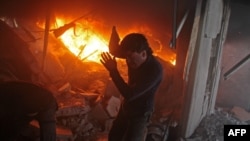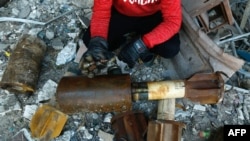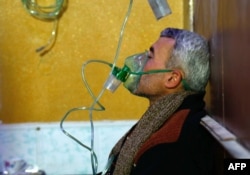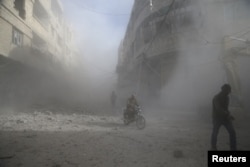The airstrikes came at a rate of one a minute, with horrible results: civilians fleeing collapsing buildings, children trapped under slabs of concrete, paramedics grimly rushing the bloodied victims away on stretchers. At least 100 people were killed in one day.
The government's assault on the rebel-controlled suburbs east of the Syrian capital, Damascus, has been a long time coming. Monday's carnage, which continued throughout Tuesday, was the deadliest in eastern Ghouta in three years.
Starved and battered by the government for years, the rebellious area has eluded President Bashar al-Assad's control despite being encircled and sporadically bombarded since 2013. Now, it appears the Syrian government and its Russian backers have decided to retake the territory at any cost.
Much like rebel-held eastern Aleppo in late 2016, eastern Ghouta is set to become a blood-soaked war theater as Assad tries to bomb it into submission. Tens of thousands of people live there, along with thousands of hard-line fighters, some of whom will probably fight to the end.
Here's a look at the battle for those suburbs.
What is Ghouta?
Ghouta is an informal name for the suburbs of the Syrian capital, Damascus, that form around the Barada River, and towns in its eastern reaches, including Douma, Kfar Batna and Saqba. The residents of eastern Ghouta were among the first to rise up against Assad's rule in 2011. The area was taken over by rebels a year later as the unrest turned into an armed insurgency, then full-blown civil war.
They held on ferociously, determined to preserve the rebel position closest to the capital, denting the narrative of an Assad victory in key places. Today it is the last major opposition enclave in the area, surrounded by areas firmly under government control.
Historically an agricultural area, it has been partially besieged by the government since 2013 and completely since mid-2017. The rebel-held suburbs endured a devastating sarin gas attack in 2013 that killed hundreds of people. Over the years, residential buildings, hospitals, schools and warehouses have all been destroyed.
According to the U.N., there are 393,000 residents in eastern Ghouta, many of them internally displaced from other parts of the country, accounting for 94 percent of all Syrians living under siege today.
U.N. aid convoys rarely make it inside, and the lack of access has led to severe food shortages, starvation and malnutrition as well as a sharp rise in food prices.
Why has eastern Ghouta eluded Assad for so long?
Thousands of battle-hardened militants are entrenched in eastern Ghouta, including the powerful Army of Islam group based in Douma, and the ultra-conservative Ahrar al-Sham and Faylaq al-Rahman groups. Haya'at Tahrir al-Sham, a rebel coalition affiliated with al-Qaida, also has a presence in the area.
Despite its proximity to Assad's seat of power in Damascus, Syrian troops stretched thin by the scale of the rebellion overlooked eastern Ghouta for the first few years of the civil war while they focused on recapturing areas deemed more crucial for the government's survival, including Homs, Aleppo and areas near the border with Lebanon.
The militants of eastern Ghouta had years to dig in, amassing an abundant reserve of weapons and ammunition from supply lines that stretched to the Syrian desert. Because the region is a farming area — and once the source of most of the capital's sugar, rice, fruits and vegetables — the militants were able to grow their own food, diminishing the need for supply lines. They've also built a labyrinth of secret underground tunnels beyond the reach of airstrikes. Some supplies get in this way, but utilities have been decimated.
What happens now?
With Russia's and Iran's help, Assad has turned the war decisively in his favor, recapturing key areas of the country from rebels and Islamic State militants.
The renewed assault on eastern Ghouta is part of a broader escalation on several fronts in recent weeks as Assad and his allies step up their efforts to finish off remaining pockets of resistance — including Idlib province in the north, which houses many evacuees from Aleppo.
The government has recently sent Brigadier General Suheil al-Hassan, also known among his troops as "Tiger,'' to eastern Ghouta to lead the effort. He has led elite forces to many victories against insurgents since the conflict began, including in Aleppo and most recently in Deir el-Zour against Islamic State militants.
For Assad, victory in eastern Ghouta would remove a long-standing threat and nuisance, going a long way toward ending the seven-year rebellion against him.











